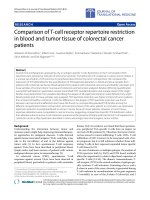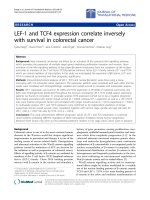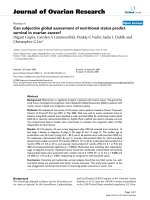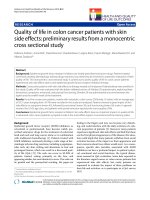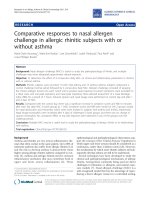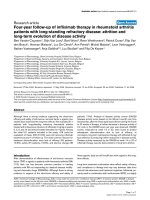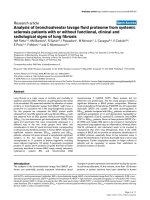Population-based SEER analysis of survival in colorectal cancer patients with or without resection of lung and liver metastases
Bạn đang xem bản rút gọn của tài liệu. Xem và tải ngay bản đầy đủ của tài liệu tại đây (1.19 MB, 9 trang )
Siebenhüner et al. BMC Cancer
(2020) 20:246
/>
RESEARCH ARTICLE
Open Access
Population-based SEER analysis of survival
in colorectal cancer patients with or
without resection of lung and liver
metastases
Alexander R. Siebenhüner1* , Ulrich Güller2,3,4 and Rene Warschkow5,6
Abstract
Background: Approximately one third of all patients with CRC present with, or subsequently develop, colorectal
liver metastases (CRLM). The objective of this population-based analysis was to assess the impact of resection of
liver only, lung only and liver and lung metastases on survival in patients with metastatic colorectal cancer (mCRC)
and resected primary tumor.
Methods: Ten thousand three hundred twenty-five patients diagnosed with mCRC between 2010 and 2015 with
resected primary were identified in the Surveillance, Epidemiology and End Results (SEER) database. Overall, (OS)
and cancer-specific survival (CSS) were analyzed by Cox regression with multivariable, inverse propensity weight,
near far matching and propensity score adjustment.
Results: The majority (79.4%) of patients had only liver metastases, 7.8% only lung metastases and 12.8% metastases of
lung and liver. 3-year OS was 44.5 and 27.5% for patients with and without metastasectomy (HR = 0.62, 95% CI: 0.58–
0.65, P < 0.001). Metastasectomy uniformly improved CSS in patients with liver metastases (HR = 0.72, 95% CI: 0.67–0.77,
P < 0.001) but not in patients with lung metastases (HR = 0.84, 95% CI: 0.62–1.12, P = 0.232) and combined liver and
lung metastases (HR = 0.89, 95% CI: 0.75–1.06, P = 0.196) in multivariable analysis. Adjustment by inverse propensity
weight, near far matching and propensity score and analysis of OS yielded similar results.
Conclusions: This is the first SEER analysis assessing the impact of metastasectomy in mCRC patients with removed
primary tumor on survival. The analysis provides compelling evidence of a statistically significant and clinically
relevant increase in OS and CSS for liver resection but not for metastasectomy of lung or both sites.
Keywords: Colorectal cancer, Right and left sided tumor, Liver metastasis, Lung metastasis, Chemotherapy,
Surgery, Surveillance epidemiology and end results database (SEER), Propensity score analysis
* Correspondence:
1
Clinic for Medical Oncology and Hematology, University Hospital Zurich and
University of Zurich, CH-8091 Zürich, Switzerland
Full list of author information is available at the end of the article
© The Author(s). 2020 Open Access This article is licensed under a Creative Commons Attribution 4.0 International License,
which permits use, sharing, adaptation, distribution and reproduction in any medium or format, as long as you give
appropriate credit to the original author(s) and the source, provide a link to the Creative Commons licence, and indicate if
changes were made. The images or other third party material in this article are included in the article's Creative Commons
licence, unless indicated otherwise in a credit line to the material. If material is not included in the article's Creative Commons
licence and your intended use is not permitted by statutory regulation or exceeds the permitted use, you will need to obtain
permission directly from the copyright holder. To view a copy of this licence, visit />The Creative Commons Public Domain Dedication waiver ( applies to the
data made available in this article, unless otherwise stated in a credit line to the data.
Siebenhüner et al. BMC Cancer
(2020) 20:246
Background
Colorectal cancer (CRC) is one of the most frequent malignant tumors. Indeed, based on the latest update of the
national cancer statistics at the United States, CRC has
the third highest incidence in both men and in women
[1]. The incidence rate is estimated to be 1.2 million per
annum in the US, and more than 600,000 patients die
from this cancer every year [2]. Approximately one third
of all patients with CRC present with, or subsequently
develop, colorectal liver metastases (CRLM). Moreover,
another 23–38% of patients already have, or will develop
extra-hepatic disease [3–5].
Over the past years the landscape of treatment modalities in patients with metastatic colorectal cancer has expanded tremendously and improved the median overall
survival (OS) from a median of 5 months in 1993 [6] to
more than 3 years nowadays [7]. Factors improving
median survival rates of metastatic CRC are a better
understanding of the heterogeneity of the disease based
on rat sarcoma (RAS) and rapidly accelerated fibrosarcoma- (RAF) mutations as well as mismatch repair
status, which allows a more patient-tailored treatment
using antibody treatment in combination with chemotherapy or immunotherapy [8–12]. Moreover, the location of the primary cancer – left versus right hemicolon
– has been recognized as important prognostic and
predictive factor, particularly regarding the efficacy of
epidermal growth factor receptor (EGFR) antibodies
[13–16]. Despite this, rapidly accumulating knowledge
about tumor heterogeneity of metastatic colorectal cancer (mCRC), many relevant questions regarding treatment sequences as well the impact and timing of
resection of lung and liver metastases remain. The latest
versions of national and international guidelines include
resection of metastases at some point in the treatment
of mCRC. However, these recommendations are often
vague [17, 18]. While it is well recognized that liver resections in curative intent should be performed, there is
ongoing debate regarding the resection of lung metastases and both lung and liver metastases.
Hence, the objective of the present populationbased analysis was to assess the impact of resection
of liver only, lung only and liver and lung metastases
on survival in patients with mCRC with resected primary tumor.
Methods
Study cohort
The 2015 custom text data-version of the Surveillance,
Epidemiology, and End Results (SEER) Program of the
National Cancer Institute in the United States, covering approximately 28% of cancer cases in the United
States, was the source of the present population-based
analysis [19].
Page 2 of 9
Study design
All patients diagnosed with colorectal cancer between
2010 and 2015 were eligible for the analysis. Patients
aged below 18 years, with missing diagnosis by histology,
secondary malignancies preceding the mCRC, other histology than adenocarcinoma, incomplete staging, nonmetastatic cancer, overlapping or unknown localization
of the primary, metastasis other than liver and/or lung,
undefined localization of the metastasis, not-resected
primary, and unknown non − primary surgery or non −
primary surgery limited to distant lymph nodes were
excluded. Figure 1 depicts the selection process.
Statistical methods
Statistical analyses were performed using the R statistical
software (www.r-project.org). A two-sided p-value < 0.05
was considered statistically significant. Cancer-specific
(CSS) and overall survivals were the co-primary endpoints. P-values were estimated using likelihood-ratio
tests. The proportional hazard assumption for Cox regression was tested by scaled Schoenfeld residuals and
by inspection of the hazard ratio (HR) plots [20]. After
descriptive analysis, the imbalances regarding prognostic
factors between patients with and without metastasectomy were assessed by multivariable logistic regression
with adjustment for the site of the primary, metastatic
site (lung, liver, both), T-stage, nodal status, grading,
chemotherapy [21], year of diagnosis, age, gender, ethnicity, and marital status (risk set). The impact of metastasectomy on survival was analyzed with and without
adjustment for the risk set. The impact of metastasectomy on survival was further analyzed with inverse propensity weight adjustment (stabilized weights) using the
“ipw” R package [22]. Thereafter an exact matched propensity score and weighted analysis was performed as a
superior and more refined statistical method for adjustment [23–25] using the “MatchIt” R package [26]. Each
patient with metastasectomy was matched to all possible
patients without with exactly the same values on all the
covariates in the risk set, forming subclasses such that
within each subclass both weighted groups have exactly
the same covariate values. Patients without a counterpart
among the patients in the other group were excluded
from this analysis. Finally, a near-far matched analysis
was performed to assess the impact of metastasectomy
with adjustment for unobserved confounding variables.
FIPS county codes were used as the instrumental variable to build an encouraged and discouraged group according to county codes with a high and low rate of
metastasectomy. These two groups were then matched
and analyzed in a paired Cox-regression model.
Thereafter, the entire analysis was repeated in each of
the three groups according to the site of the metastasis
Siebenhüner et al. BMC Cancer
(2020) 20:246
Page 3 of 9
Fig. 1 Flow chart of patients’ cohort definition. Data from the Surveillance, Epidemiology, and End Results (SEER) Program of the National Cancer
Institute in the United States, covering approximately 28% of cancer cases in the United States were used for the present population-based
analysis. Of 217,068 patients diagnosed with colorectal cancer between 2010 and 2015, 10,325 were eligible for analysis at the end of the
selection process
using the same risk set except from the site of the
metastasis.
Results
Patients characteristics
Ten thousand three hundred twenty-five of 217,068 patients diagnosed with colorectal cancer between 2010
and 2015 were included (Fig. 1). The median follow-up
time was 15 months (interquartile range: 6 to 28 months)
for all patients and 19 months (interquartile range: 8 to
35 months) for those alive at the end of follow up. At
the end of follow-up, 4299 (41.6%) patients were alive,
5667 (54.9%) died from cancer and 359 (3.5%) from
other reasons. Overall, 8195 (79.4%) patients had liver
metastases only, 807 (7.8%) patients presented with lung
metastases only and 1323 (12.8%) presented with metastases on both sites (Table 1). Metastasectomy was performed in 2906 (28.1%) patients. The multivariable
Siebenhüner et al. BMC Cancer
(2020) 20:246
Page 4 of 9
Table 1 Patient characteristics
Resection
Metastasis
Tumor localization
T-Stage
Total
N = 10,325
Resection
No Resection
N = 7419
Resection
N = 2906
Pa
Liver
N = 8195
Metastasis
Lung
N = 807
Both
N = 1323
Pa
No
7419 (71.9%)
7419 (100%)
–
–
5695 (69.5%)
663 (82.2%)
1061 (80.2%)
< 0.001
Yes
2906 (28.1%)
–
2906 (100%)
Liver only
8195 (79.4%)
5695 (76.8%)
2500 (86.0%)
–
807 (7.8%)
663 (8.9%)
144 (5.0%)
–
807 (100%)
–
1061 (14.3%)
262 (9.0%)
–
–
1323 (100%)
Right colon
3485 (33.8%)
2602 (35.1%)
883 (30.4%)
Transverse
1401 (13.6%)
1005 (13.5%)
396 (13.6%)
2808 (34.3%)
220 (27.3%)
457 (34.5%)
1140 (13.9%)
98 (12.1%)
163 (12.3%)
Left colon
3311 (32.1%)
2346 (31.6%)
Rectosigmoid
966 (9.4%)
680 (9.2%)
965 (33.2%)
2666 (32.5%)
231 (28.6%)
414 (31.3%)
286 (9.8%)
736 (9.0%)
88 (10.9%)
142 (10.7%)
Rectum
1162 (11.3%)
786 (10.6%)
376 (12.9%)
T1 to T3
6643 (64.3%)
4727 (63.7%)
1916 (65.9%)
845 (10.3%)
170 (21.1%)
147 (11.1%)
5348 (65.3%)
532 (65.9%)
763 (57.7%)
2847 (34.7%)
275 (34.1%)
560 (42.3%)
1654 (20.2%)
230 (28.5%)
219 (16.6%)
6541 (79.8%)
577 (71.5%)
1104 (83.4%)
6090 (74.3%)
615 (76.2%)
1010 (76.3%)
2105 (25.7%)
192 (23.8%)
313 (23.7%)
2216 (27.0%)
235 (29.1%)
391 (29.6%)
3682 (35.7%)
2692 (36.3%)
990 (34.1%)
2103 (20.4%)
1439 (19.4%)
664 (22.8%)
N+
8222 (79.6%)
5980 (80.6%)
2242 (77.2%)
Grade
G1/2
7715 (74.7%)
5450 (73.5%)
2265 (77.9%)
G3/4
2610 (25.3%)
1969 (26.5%)
641 (22.1%)
Chemo- and/or
No
2842 (27.5%)
2294 (30.9%)
548 (18.9%)
Radiotherapy
Yes
7483 (72.5%)
5125 (69.1%)
2358 (81.1%)
Year of diagnosis
2010–2012
5304 (51.4%)
3915 (52.8%)
1389 (47.8%)
Marital status
262 (19.8%)
–
1323 (12.8%)
N0
Ethnicity
144 (17.8%)
8195 (100%)
Lung only
T4
Gender
2500 (30.5%)
Liver and Lung
N-Stage
Age (years)
< 0.001
< 0.001
0.034
< 0.001
< 0.001
< 0.001
5979 (73.0%)
572 (70.9%)
932 (70.4%)
< 0.001
4279 (52.2%)
365 (45.2%)
660 (49.9%)
3916 (47.8%)
442 (54.8%)
663 (50.1%)
< 0.001
1474 (18.0%)
120 (14.9%)
205 (15.5%)
2013–2015
5021 (48.6%)
3504 (47.2%)
1517 (52.2%)
< 50
1799 (17.4%)
1130 (15.2%)
669 (23.0%)
50–64
4065 (39.4%)
2843 (38.3%)
1222 (42.1%)
3241 (39.5%)
285 (35.3%)
539 (40.7%)
65–79
3247 (31.4%)
2448 (33.0%)
799 (27.5%)
2525 (30.8%)
285 (35.3%)
437 (33.0%)
955 (11.7%)
117 (14.5%)
142 (10.7%)
4585 (55.9%)
387 (48.0%)
721 (54.5%)
3610 (44.1%)
420 (52.0%)
602 (45.5%)
6237 (76.1%)
591 (73.2%)
959 (72.5%)
80+
1214 (11.8%)
998 (13.5%)
216 (7.4%)
Male
5693 (55.1%)
4159 (56.1%)
1534 (52.8%)
Female
4632 (44.9%)
3260 (43.9%)
1372 (47.2%)
Caucasian
7787 (75.4%)
5576 (75.2%)
2211 (76.1%)
African-American
1555 (15.1%)
1117 (15.1%)
438 (15.1%)
1219 (14.9%)
115 (14.3%)
221 (16.7%)
Other/Unknown
983 (9.5%)
726 (9.8%)
257 (8.8%)
739 (9.0%)
101 (12.5%)
143 (10.8%)
Married
5583 (54.1%)
3925 (52.9%)
1658 (57.1%)
4501 (54.9%)
399 (49.4%)
683 (51.6%)
Single/Widowed
3057 (29.6%)
2256 (30.4%)
801 (27.6%)
2398 (29.3%)
259 (32.1%)
400 (30.2%)
Other/Unknown
1685 (16.3%)
1238 (16.7%)
447 (15.4%)
1296 (15.8%)
149 (18.5%)
240 (18.1%)
0.003
0.336
< 0.001
–
< 0.001
< 0.001
< 0.001
0.118
0.437
0.005
0.005
0.003
0.117
0.061
n (percent)
a
Chi-squared test
logistic regression confirmed the significant imbalances
in the baseline characteristics between patients with and
without metastasectomy for the entire risk set except for
the site of the primary, T-stage and ethnicity.
Impact of metastasectomy on survival for all metastatic sites
The median CSS in patients with and without metastasectomy was 2.8 and 1.8 years and the 3-year survival
rates were 46.3% (95% confidence interval (CI): 44.1–
48.7%) and 29.4% (95% CI: 28.1–30.7%, HR = 0.62, 95%
CI: 0.58–0.66, P < 0.001), respectively. The median OS in
patients with and without metastasectomy was 2.6 and
1.7 years and the 3-year survival rates were 44.5% (95%
CI: 42.3–46.8%) and 27.5% (95% CI: 26.2–28.7%, HR =
0.62, 95% CI: 0.58–0.65, P < 0.001), respectively. In
multivariable analysis, metastasectomy was associated
with improved CSS (HR = 0.75, 95% CI: 0.70–0.80, P <
0.001) and OS (HR = 0.75, 95% CI: 0.70–0.80, P < 0.001).
Survival was better when the metastatic site was in the
lung only and worse when occurring on both liver and
Siebenhüner et al. BMC Cancer
(2020) 20:246
Page 5 of 9
lung data (Table 2). Survival was better in left sided
colonic and rectal cancer, in nodal negative patients
with lower T-stage and lower graded tumors and in
younger, married, Caucasian patients who underwent
chemotherapy (Table 2).
(17.8%) patients with exclusively lung metastases and in
262 of 1323 (19.8%) patients with metastases on both
sites. Figure 3 summarizes the impact of metastasectomy
for OS and CSS in stratified analyses performed separately for the three metastatic site groups.
Impact of metastasectomy on survival stratified for the
metastatic sites
Resection of liver metastases only
Metastasectomy was performed in 2500 of 8195 (30.5%)
patients with exclusively liver metastases, in 144 of 807
The stratified analysis demonstrated liver being the only
metastatic site, for which metastasectomy was uniformly
Table 2 Prognostic factors for overall and cancer-specific survival
overall survival using Cox regression
unadjusteda
Resection
Metastasis
Tumor localization
T-Stage
N-Stage
Grade
Chemo- and/or
HR (95% CI)
p
HR (95% CI)
p
HR (95% CI)
pc
No
Reference
< 0.001
Reference
< 0.001
Reference
< 0.001
Reference
< 0.001
Yes
0.62 (0.58–0.65)
Liver only
Reference
Lung only
0.78 (0.70–0.86)
0.69 (0.62–0.76)
0.75 (0.68–0.84)
0.67 (0.60–0.75)
Liver and Lung
1.62 (1.51–1.74)
1.58 (1.47–1.69)
1.64 (1.52–1.76)
1.59 (1.48–1.71)
< 0.001
Reference
0.91 (0.84–0.98)
1.01 (0.93–1.10)
Left
0.61 (0.57–0.65)
0.77 (0.72–0.82)
0.61 (0.57–0.65)
0.77 (0.72–0.82)
Rectosigmoid
0.58 (0.53–0.64)
0.72 (0.66–0.80)
0.58 (0.53–0.64)
0.73 (0.66–0.80)
Rectum
0.46 (0.42–0.50)
T1 to T3
Reference
T4
1.60 (1.52–1.69)
N0
Reference
N1
1.64 (1.54–1.76)
G1/2
Reference
G3/4
1.73 (1.63–1.82)
No
Reference
0.75 (0.68–0.83)
Reference
0.46 (0.41–0.50)
< 0.001
1.44 (1.37–1.52)
< 0.001
Reference
Reference
Reference
< 0.001
Reference
< 0.001
Reference
Reference
Reference
Reference
0.044
Reference
< 0.001
Reference
0.34 (0.32–0.36)
Reference
Reference
Reference
Reference
Reference
< 0.001
Reference
0.89 (0.84–0.94)
Reference
0.89 (0.84–0.94)
50–64
1.24 (1.14–1.34)
1.12 (1.03–1.21)
1.21 (1.12–1.31)
1.10 (1.01–1.19)
65–79
1.71 (1.58–1.85)
1.35 (1.25–1.47)
1.62 (1.50–1.76)
1.29 (1.19–1.41)
80+
3.59 (3.28–3.94)
male
Reference
female
1.04 (0.99–1.10)
Caucasian
Reference
African-American
1.15 (1.08–1.24)
1.11 (1.04–1.20)
1.15 (1.08–1.24)
1.11 (1.03–1.20)
other/unknown
0.91 (0.83–1.00)
0.91 (0.83–0.99)
0.90 (0.82–0.99)
0.89 (0.81–0.98)
married
Reference
single
1.46 (1.38–1.55)
1.21 (1.14–1.28)
1.45 (1.36–1.53)
1.20 (1.13–1.28)
other/unknown
1.12 (1.05–1.21)
1.05 (0.98–1.13)
1.09 (1.01–1.17)
1.02 (0.94–1.10)
0.048
0.95 (0.90–1.00)
< 0.001
< 0.001
Reference
Reference
Reference
< 0.001
Hazard ratios (HR) with 95% confidence intervals (CI) of Wald type
a
univariate Cox regression analysis; bmultivariable Cox regression analysis; clikelihood ratio test
Reference
Reference
0.052
< 0.001
1.85 (1.67–2.05)
0.034
1.06 (1.00–1.12)
< 0.001
< 0.001
0.94 (0.89–1.00)
3.35 (3.05–3.69)
Reference
< 0.001
0.35 (0.33–0.37)
< 0.001
< 50
1.96 (1.77–2.17)
< 0.001
1.53 (1.44–1.62)
< 0.001
2013–2015
0.106
< 0.001
1.65 (1.53–1.78)
< 0.001
0.30 (0.28–0.31)
0.94 (0.89–1.00)
< 0.001
1.47 (1.40–1.56)
< 0.001
1.77 (1.67–1.87)
< 0.001
Reference
< 0.001
0.75 (0.68–0.83)
< 0.001
1.74 (1.62–1.87)
< 0.001
1.50 (1.42–1.59)
< 0.001
Reference
1.74 (1.62–1.87)
< 0.001
1.57 (1.47–1.69)
< 0.001
< 0.001
Reference
1.01 (0.93–1.09)
< 0.001
Reference
0.75 (0.70–0.80)
< 0.001
Reference
0.29 (0.27–0.30)
Reference
0.62 (0.58–0.66)
< 0.001
0.91 (0.84–0.98)
Reference
< 0.001
Reference
Right
Yes
Marital status
0.75 (0.70–0.80)
< 0.001
c
Transverse
2010–2012
Ethnicity
c
full modelb
p
Radiotherapy
Gender
c
unadjusteda
HR (95% CI)
Year of diagnosis
Age (years)
cancer-specific survival using Cox regression
full modelb
Reference
0.2227
0.97 (0.92–1.02)
< 0.001
< 0.001
Reference
Reference
0.001
< 0.001
Siebenhüner et al. BMC Cancer
(2020) 20:246
beneficial regarding OS and CSS in unadjusted and all
adjusted analyses (Figs. 2 and 3).
Resection of lung metastases only
For lung as the only metastatic site, metastasectomy was
beneficial only in unadjusted analysis. The median OS in
patients with and without lung metastasectomy was 3.3
and 2.5 years and the 3-year survival rates were 58.0%
(95% CI: 49.1–68.4%) and 40.9% (95% CI: 36.3–46.1%)
(HR = 0.73, 95% CI: 0.56–0.95, P = 0.016). However, after
multivariable adjustment, lung metastasectomy did not
have a significant impact on OS (HR = 0.86, 95% CI:
0.65–1.14, P = 0.280) and CSS (HR = 0.84, 95% CI: 0.62–
1.12, P = 0.232). Furthermore, no benefit on CSS and OS
was found in patients undergoing resection of lung metastases after propensity score- (PS) and inverse probability weighted- (IPW) adjustment (Figs. 2 and 3).
Resection of combined lung and liver metastases
In patients with both lung and liver metastases, metastasectomy was beneficial only in unadjusted analysis. The
median overall survivals in patients with and without
metastasectomy were 1.5 and 1.2 years. However, none
of the adjusted analyses yielded a survival benefit for patients undergoing metastasectomy (Figs. 2 and 3).
Discussion
This is the first SEER analysis using IPW and PS to assess
the impact of metastasectomy on survival in colorectal
Page 6 of 9
cancer patients with special focus on liver and/or lung
metastases and with removed primary tumor. The
present analysis provides compelling evidence of a
statistically significant and clinically relevant increase in
OS and CSS for liver resection but not for metastasectomy of lung or both sites.
Outcomes of patients with metastatic colorectal cancer
(mCRC) have improved enormously over the last decade.
Indeed, depending on the extent of metastases and the
biology, the median OS of metastatic colorectal cancer
patients can exceed 3 years [27]. There are different
factors, which led to improved outcomes in patients with
metastatic colorectal cancer: first, our knowledge of the
tumor heterogeneity based on molecular profiling has
changed the therapeutic management of these tumors.
Thus, the more individual systemic treatment results in
higher response rates and consecutively higher rates of
surgical metastasectomy. These therapeutic concepts are
well approved in large randomized trials in the first line
as well second line settings [11, 28]. As refractory
patients will be seen more frequently in sequential treatment of mCRC re-challenge concepts have been investigated with promising results [29, 30].
However, the therapeutic concepts of mCRC do not
only contain chemotherapy or antibodies. Resections of
oligometastatic liver and or lung metastasis are commonly
discussed during multidisciplinary tumor boards and up
to 15% of mCRC patients are evaluated for resection. The
surgical management along the current guidelines of
Fig. 2 Forest plot of unadjusted and adjusted survival analysis stratified for metastatic siteAnalysis of survival was performed separately for
patients with liver only, lung only, lung and liver being the metastatic site. The 95% confidence intervals for the hazard ratios were estimated
using the Wald method and the P-values using the likelihood ratio test. The figure depicts the results for OS and CSS in unadjusted, multivariable
adjusted, inverse propensity weight (IPW)-adjusted and exact matching and weighting propensity score adjusted analysis.
Siebenhüner et al. BMC Cancer
(2020) 20:246
Page 7 of 9
Fig. 3 Unadjusted and PS-adjusted survival analysis stratified for metastatic site. The upper three plots display the survival curves for cancerspecific survival in unadjusted analysis for patients with liver, lung and both metastasis with and without resection (Panel A to C). The lower three
plots display the survival curves after exact propensity matching (Panel D to F)
National Comprehensive Cancer Network (NCCN) and
European Society for Medical Oncology (ESMO) is not restricted to one single organ as well no clear definition on
the number of metastasis at liver or lung will restrict such
procedures within a multidisciplinary approach to mCRC
patients [17, 18]. However, good prognostic and predictive
makers to guide this decision are still missing.
The benefit of metastatic resection for these selected
patients led to an improvement of 5-years survival of
20–38% [31–33]. Most available data supporting resection
of liver and or lung metastases are based on small case
series as well retrospective data and reviews [34, 35]. Large
cohort analyses to address the impact of metastasectomy
in relation to OS or CSS are scarse.
To our knowledge this is the first population-based,
propensity score adjusted analysis investigating the prognostic impact of resection of liver and or lung metastases
in mCRC patients. Being aware of the conflicting data and
the challenge to handle relevant bias due to substantial
imbalances between resected versus not resected mCRC
patients, we have intentionally selected the propensity
score matching as a superior and refined statistical
method in addition to commonly used multivariate
analysis.
Based on a large collective from the SEER database of
patients with metastatic colorectal cancer between 2010
and 2015 with resected primary tumor, the present study
provides compelling evidence that the prognosis of patients with resection of liver metastasis in the overall
population is better after adjusting for a strong bias regarding various patient and tumor characteristics by
the use of the propensity score matching. Conversely,
no differences in OS and CSS appeared in the propensity score adjusted population for the patients undergoing resection of lung metastases or both lung and liver
metastases. Thus, we conclude that the overall survival
improvement in mCRC patients after resection of lung
and both lung and liver metastases described in the scientific literature are not real on a population-based
level but caused by differences regarding confounders
that could not be adjusted for in multivariate regression
analysis.
Our results differ from the finding from Boysen et al. [36]
demonstrating a survival benefit of lung metastasectomy
Siebenhüner et al. BMC Cancer
(2020) 20:246
compared to the group of no resection. However, in this
Danish cohort study the benefit for lung metastasectomy
was only found in univariate analyses and non-significant
benefit was seen at their multivariate analysis for lung
metastasectomy, hence selection bias (healthier patients
with less metastatic disease, and better biology get operated) is inherent. Luo et colleagues [37] demonstrated in
their SEER database analysis that the metastatic site of patients with mCRC has prognostic impact. Indeed, isolated
liver metastases have a better prognosis compared to metastases at multiple sites. However, the authors did not
analyze the impact on outcomes of resection and survival
of mCRC patients.
In highly selected patients there might be a benefit for
a sequential metastasectomy of liver followed by systemic treatment followed by metastasectomy of the lung.
However, the patient numbers in published analyses are
low and without control group [38–42]. The same trend
of survival benefit was reported for patients with mCRC
after lung resection [43–45]. The limitations of these
studies are the retrospective nature, inclusion of a highly
selective patient cohort and most of them were done at
a highly specialized cancer center and hence lack the
generalizability to other hospitals. Most importantly, no
thorough risk-adjustment was performed with propensityscore analyses and hence relevant selection bias is an inherent shortcoming. This explains the different results
compared to our study, in which we aimed to properly
address and limit selection bias.
Our study has some limitations, most of them by the
lack of information which were not available from the
SEER database. In fact, the SEER database does not provide any information about the intention or the extend
of metastasectomy. Hence, we can not ascertain if all the
three groups underwent metastasectomy with curative
intention. However, there is some evidence that resection of lung metastasis in the setting of liver and lung
metastasis in mCRC does not improve the survival [46],
which is in accordance to our findings.
One limitation is the lack of biomarker information regarding RAS and rapidly accelerated fibrosarcoma isoform
B (BRAF) mutations as well as microsatellite instability.
Second, no information concerning the choice of systemic
therapy as well the status of conversion rate for resection
of initially unresectable metastasis are available. Third,
information regarding the time-point of resection, type of
surgery as well the resection margin (R0 or R1) was lacking. Fourth, the SEER database does not provide any information regarding the diagnosis of pulmonary metastasis.
Hence it is possible, that small pulmonary nodules in
computed tomography (CT) scans were benign. However,
due to the population-based nature of this analysis that reflects the real United States population with metastatic
colon cancer, the lack of this information does not impact
Page 8 of 9
our results, albeit limits the extent of interpretation
of our data.
Conclusion
This population-based propensity score adjusted analysis
of mCRC patients with liver and or lung metastases provides compelling evidence that the resection of liver metastases improves OS and CSS. In contrary, the resection
lung metastases as well as both lung and liver metastases
did not result in increased survival.
Abbreviations
BRAF: Rapidly accelerated fibrosarcoma isoform B; CI: Confidence interval;
CRC: Colorectal cancer; CRLM: Colorectal liver metastases; CSS: Cancer
specific survival; CT: Computed tomography; EGFR: Epidermal growth factor;
ESMO: European Society for Medical Network; HR: Hazard ratio; IPW: Inverse
probability weighted; mCRC: metastatic colorectal cancer; NCCN: National
Comprehensive Cancer Network; OS: Overall survival; PS: Propensity score;
RAF: Rapidly accelerated fibrosarcoma; RAS: Rat sarcoma; SEER: Surveillance
epidemiology and end results database
Acknowledgements
Not applicable
Authors’ contributions
ARS participated in interpretation of the data analysis, conducting literature
search, figures, and drafting, writing, and critical reviewing of the manuscript.
UG participated in study design, interpretation of the data analysis, literature
search, figures, and writing and critical reviewing of manuscript. RW
participated in study design, performing data analysis, interpretation of the
data analysis, literature search, and manuscript writing and critical reviewing.
All authors read and approved the final manuscript.
Funding
This study was not funded by any source.
Availability of data and materials
The data used in this study are available free of charge online at www.seer.
cancer.gov on request.
All data generated or analyzed during this study are included in this
published article.
Ethics approval and consent to participate
This study was based on public use de-identified data from the SEER database and did not involve interaction with human subjects or use personal
identifying information. The study did not require informed consent from
the SEER registered cases and the authors obtained Limited-Use Data Agreements from SEER. No trial registration was necessary.
Consent for publication
Not applicable
Competing interests
The authors declared that they have no competing interest. No third-party financial funds or materials were accepted or necessary for execution of this
research project.
Author details
1
Clinic for Medical Oncology and Hematology, University Hospital Zurich and
University of Zurich, CH-8091 Zürich, Switzerland. 2University Clinic for
Visceral Surgery and Medicine, University Hospital Berne, CH-3010 Berne,
Switzerland. 3Onkologie und Hämatologiezentrum Stial STS AG, CH-3600
Thun, Switzerland. 4Division of Medical Oncology and Hematology,
Kantonsspital St. Gallen, CH-9007 St. Gallen, Switzerland. 5Department of
Surgery, Kantonsspital St. Gallen, CH-9007 St. Gallen, Switzerland. 6Institute of
Medical Biometry and Informatics, University Heidelberg, 69120 Heidelberg,
Germany.
Siebenhüner et al. BMC Cancer
(2020) 20:246
Received: 30 December 2019 Accepted: 3 March 2020
References
1. Cronin KA, et al. Annual report to the nation on the status of cancer, part I:
national cancer statistics. Cancer. 2018;124(13):2785–800.
2. Brenner H, Kloor M, Pox CP. Colorectal cancer. Lancet. 2014;383(9927):
1490–502.
3. Kune GA, et al. Survival in patients with large-bowel cancer. A populationbased investigation from the Melbourne colorectal cancer study. Dis Colon
Rectum. 1990;33(11):938–46.
4. Manfredi S, et al. Epidemiology and management of liver metastases from
colorectal cancer. Ann Surg. 2006;244(2):254–9.
5. van der Geest LG, et al. Nationwide trends in incidence, treatment and
survival of colorectal cancer patients with synchronous metastases. Clin Exp
Metastasis. 2015;32(5):457–65.
6. Scheithauer W, et al. Randomised comparison of combination
chemotherapy plus supportive care with supportive care alone in patients
with metastatic colorectal cancer. BMJ. 1993;306(6880):752–5.
7. Geva R, et al. Retrospective analysis of efficacy and safety of third-line
chemotherapy for metastatic colorectal cancer among elderly patients
receiving targeted therapy in early lines. JCGG. 2015;6(3):95–99.
8. Stintzing S, et al. Impact of BRAF and RAS mutations on first-line efficacy of
FOLFIRI plus cetuximab versus FOLFIRI plus bevacizumab: analysis of the
FIRE-3 (AIO KRK-0306) study. Eur J Cancer. 2017;79:50–60.
9. Stintzing S, et al. FOLFIRI plus cetuximab versus FOLFIRI plus bevacizumab
for metastatic colorectal cancer (FIRE-3): a post-hoc analysis of tumour
dynamics in the final RAS wild-type subgroup of this randomised openlabel phase 3 trial. Lancet Oncol. 2016;17(10):1426–34.
10. Elez E, Argiles G, Tabernero J. First-line treatment of metastatic colorectal
cancer: interpreting FIRE-3, PEAK, and CALGB/SWOG 80405. Curr Treat
Options in Oncol. 2015;16(11):52.
11. Arnold D, et al. Prognostic and predictive value of primary tumour side in
patients with RAS wild-type metastatic colorectal cancer treated with
chemotherapy and EGFR directed antibodies in six randomized trials. Ann
Oncol. 2017;28(8):1713–29.
12. Kroemer G, et al. Colorectal cancer: the first neoplasia found to be under
immunosurveillance and the last one to respond to immunotherapy?
Oncoimmunology. 2015;4(7):e1058597.
13. Saltzstein SL, Behling CA. Age and time as factors in the left-to-right shift of
the subsite of colorectal adenocarcinoma: a study of 213,383 cases from the
California cancer registry. J Clin Gastroenterol. 2007;41(2):173–7.
14. Elnatan J, Goh HS, Smith DR. C-KI-RAS activation and the biological
behaviour of proximal and distal colonic adenocarcinomas. Eur J Cancer.
1996;32A(3):491–7.
15. Benedix F, et al. Comparison of 17,641 patients with right- and left-sided
colon cancer: differences in epidemiology, perioperative course, histology,
and survival. Dis Colon Rectum. 2010;53(1):57–64.
16. Clark S, Suttie SA, Shaikh I, Mullen R, et al. Outcome of right- and left-sided
colonic and rectal cancer following surgical resection. Color Dis. 2011;13:
884–9 Colorectal Dis, 2012. 14(3): p. 386; author reply 386-7.
17. Yoshino T, et al. Pan-Asian adapted ESMO consensus guidelines for the
management of patients with metastatic colorectal cancer: a JSMO-ESMO
initiative endorsed by CSCO, KACO, MOS, SSO and TOS. Ann Oncol. 2018;
29(1):44–70.
18. Van Cutsem E, et al. ESMO consensus guidelines for the management of
patients with metastatic colorectal cancer. Ann Oncol. 2016;27(8):1386–422.
19. Surveillance Epidemiology and End Results (SEER) Program, Research Data
(National Cancer Institute, DCCPS Surveillance Research Program, Surveillance
Systems Branch, released April 2015, based on the November 2014 submission.
www.seer.cancer.gov, 1973–2012.
20. Grambsch P, Therneau T. Proportional hazards tests and diagnostics based
on weighted residuals. Biometrika. 1994;81:515–26.
21. Noone AM, et al. Comparison of SEER treatment data with Medicare claims.
Med Care. 2016;54(9):e55–64.
22. van der Wal WM, Geskus RB. Ipw: an R package for inverse probability
weighting. J Stat Softw. 2011;43:1.
23. Joffe M, Rosenbaum P. Invited commentary: propensity scores. Am J
Epidemiol. 1999;150:327–33.
24. Rosenbaum P. Model-based direct adjustment. J Am Stat Assoc. 1987;82:387–94.
Page 9 of 9
25. Rubin DB. Estimating causal effects from large data sets using propensity
scores. Ann Intern Med. 1997;127(8 Pt 2):757–63.
26. Ho D, et al. Matching as nonparametric preprocessing for reducing model
dependence in parametric causal inference. Polit Anal. 2007;15:199–236.
27. Prasanna T, et al. The survival outcome of patients with metastatic
colorectal cancer based on the site of metastases and the impact of
molecular markers and site of primary cancer on metastatic pattern. Acta
Oncol. 2018;57:1–7.
28. Siravegna G, et al. Clonal evolution and resistance to EGFR blockade in the
blood of colorectal cancer patients. Nat Med. 2015;21(7):795–801.
29. Vogel A, et al. Treatment decisions in metastatic colorectal cancer - beyond
first and second line combination therapies. Cancer Treat Rev. 2017;59:54–60.
30. Goldberg RM, et al. Optimising the use of cetuximab in the continuum of
care for patients with metastatic colorectal cancer. ESMO Open. 2018;3(4):
e000353.
31. Choti MA, et al. Trends in long-term survival following liver resection for
hepatic colorectal metastases. Ann Surg. 2002;235(6):759–66.
32. Pawlik TM, et al. Effect of surgical margin status on survival and site of
recurrence after hepatic resection for colorectal metastases. Ann Surg. 2005;
241(5):715–22 discussion 722-4.
33. Kanas GP, et al. Survival after liver resection in metastatic colorectal cancer:
review and meta-analysis of prognostic factors. Clin Epidemiol. 2012;4:283–301.
34. Van Cutsem E, et al. Towards a pan-European consensus on the treatment of
patients with colorectal liver metastases. Eur J Cancer. 2006;42(14):2212–21.
35. Kemeny N. Management of liver metastases from colorectal cancer.
Oncology (Williston Park). 2006;20(10):1161–76 1179; discussion 1179–80,
1185–6.
36. Boysen AK, et al. Metastasis directed therapy for liver and lung metastases
from colorectal cancer - a population based study. Int J Cancer. 2018;
143(12):3218.
37. Luo D, et al. Prognostic value of distant metastasis sites and surgery in
stage IV colorectal cancer: a population-based study. Int J Color Dis. 2018;
33(9):1241.
38. Brouquet A, et al. Improved survival after resection of liver and lung
colorectal metastases compared with liver-only metastases: a study of 112
patients with limited lung metastatic disease. J Am Coll Surg. 2011;213(1):
62–9 discussion 69-71.
39. Hadden WJ, et al. Resection of colorectal liver metastases and extra-hepatic
disease: a systematic review and proportional meta-analysis of survival
outcomes. HPB (Oxford). 2016;18(3):209–20.
40. Headrick JR, et al. Surgical treatment of hepatic and pulmonary metastases
from colon cancer. Ann Thorac Surg. 2001;71(3):975–9 discussion 979-80.
41. Marin C, et al. Outcome of strict patient selection for surgical treatment of
hepatic and pulmonary metastases from colorectal cancer. Dis Colon
Rectum. 2013;56(1):43–50.
42. Pulitano C, et al. Liver resection for colorectal metastases in presence of
extrahepatic disease: results from an international multi-institutional analysis.
Ann Surg Oncol. 2011;18(5):1380–8.
43. Gonzalez M, et al. Risk factors for survival after lung metastasectomy in
colorectal cancer patients: a systematic review and meta-analysis. Ann Surg
Oncol. 2013;20(2):572–9.
44. Gonzalez M, Gervaz P. Risk factors for survival after lung metastasectomy in
colorectal cancer patients: systematic review and meta-analysis. Future
Oncol. 2015;11(2 Suppl):31–3.
45. Xu L, et al. Parallel calibration revisited: the second direction for shrinkage
estimation of regression coefficients can be as natural and necessary as the
traditional one. Anal Chim Acta. 2009;644(1–2):25–9.
46. Patel D, et al. Is survival for patients with Resectable lung metastatic
colorectal cancer comparable to those with Resectable liver disease? Results
from the south Australian metastatic colorectal registry. Ann Surg Oncol.
2016;23(11):3616–22.
Publisher’s Note
Springer Nature remains neutral with regard to jurisdictional claims in
published maps and institutional affiliations.

